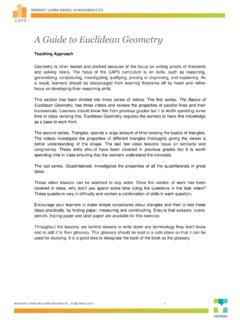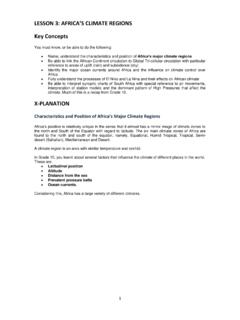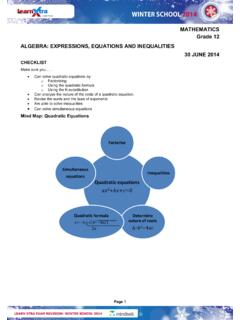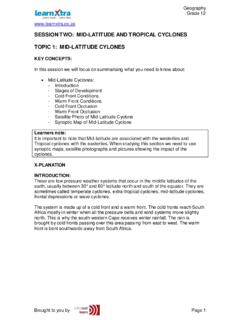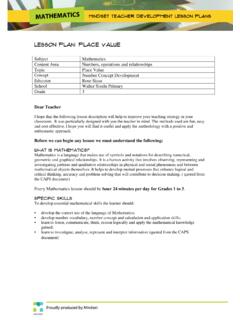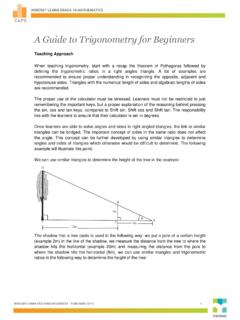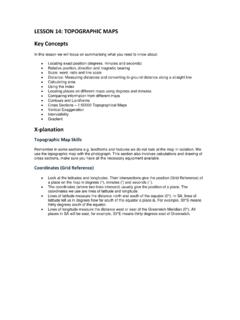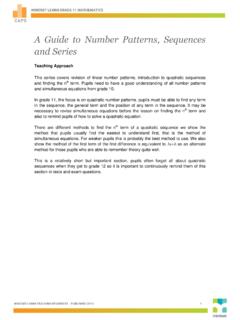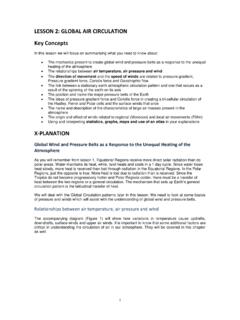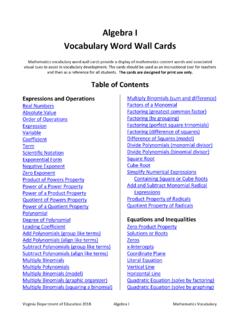Transcription of LESSON 6: GEOMORPHOLOGY II SECTION A: SLOPES
1 LESSON 6: GEOMORPHOLOGY II SECTION A: SLOPES Key Concepts In this LESSON we will focus on summarising what you need to know about: Overview of South Africa's topography Types of SLOPES slope elements Characteristics of slope elements slope development over time and the concept of slope retreat X-Planation Overview of South Africa s Topography SA s landscape has been shaped over a long time by movement below the surface of the Earth and by the movement of water across the surface of the Earth. Different layers of rocks have been laid down over millions of years and then shaped by erosion.
2 Different strata and rock formations are eroded and the topography results from these processes. What is a slope ? The angle which any part of the Earth s surface makes with the horizontal OR Any geometric element of the Earth s surface. Types of SLOPES Gentle slope A slope with contour lines spread far apart from each other. This even spacing is maintained in both up and down slope . Steep slope A slope represented with contour lines close to each other on a topographical map. Convex slope A slope which becomes progressively steeper downhill.
3 It can refer to an entire slope or part of one. On a map the contour lines will be spaced closer together with a decline in height above sea-level. Concave slope A slope which becomes progressively steeper uphill. It can refer to an entire slope or part of one. On a map the Contour lines will be spaced closer with an increase in height above sea-level. Tectonic SLOPES These are formed through internal forces that result in the folding, warping and faulting of rock masses or layers. Anticlines and synclines, are formed when layers of rock are folded; while horsts (block mountains) and graben (rift valleys) are formed when blocks of land rise or fall in relation to each other when faulting occurs.
4 Depositional SLOPES Deposits of weather material build up to form inclined surfaces, mounds and hills when an agent of erosion ( wind, water or ice) which has lost its energy of motion, lays down its load in a particular place. Examples are alluvial fans, alluvial cones, deltas and sand dunes. slope Elements Crest A small convex-shaped slope , with a thin covering of soil Freeface / Scarp Cliff A near vertical slope , more than 80 to the horizontal Talus / Scree / Debris A slope with a constant angle.
5 And is formed of eroded material from crest and freeface Knickpoint The change in gradient at the base of the scree slope Pediment A low-angle concave slope Characteristics of SLOPES Crest Edge of the hill Convex Thin layer of soil Weathered material removed Freeface / Scarp Cliff > 80 to the horizon Layer hard resistant rock Loose material falls to bottom of cliff Cliff retreats parallel to itself Talus / Scree / Debris Accumulates from crest and cliff face Uniform slope Pediment Low angle, concave slope slope is not uniform- steeper close to the talus slope Pediment increases as the slope increases backwards due to scarp recession slope Development over time and the Concept of slope Retreat slope DECLINE ( DAVIS, 1899) REGION OF STUDY Theory based on SLOPES in what was to Davis a normal climate (north-western Europe and north-eastern USA)
6 CLIMATE Humid climate DESCRIPTION OF slope Steepest SLOPES at the beginning of the process with a progressively decreasing angle over time to give a convex upper slope and a concave lower slope CHANGES OVER TIME Assumed a rapid uplift of land with an immediate onset of denudation. The uplifted land would undergo a cycle of erosion where SLOPES were initially made steeper by vertical erosion by rivers but later became less steep ( slope decline) until the land was almost flat (peneplain) slope REPLACEMENT (W.)
7 PENCK, 1924) REGION OF STUDY Conclusions drawn from evidence of SLOPES in the Alps and Andes CLIMATE Tectonic areas DESCRIPTION OF slope The maximum angle decreases as the gentler lower SLOPES erode back to replace the steeper ones giving a concave central part of to the slope CHANGES OVER TIME Assumed landscape started with a vertical rock slope with equal weathering overall. As scree (talus) collected at the foot of the cliff it gave a gentler slope which, as the scree grew, replaced the original one.
8 parallel RETREAT ( KING, 1948, 1957) REGION OF STUDY Based on SLOPES in South Africa CLIMATE Semi-arid landscapes. Also sea cliffs with wave-cut platforms DESCRIPTION OF slope The maximum angle remains constant as do all slope facets apart from the lower one which increases in concavity CHANGES OVER TIME Assumed that SLOPES had two facets- a gently concave lower slope or pediment and a steeper upper slope (scarp). Weathering caused the parallel retreat of the scarp slope allowing the pediment to extend in size X-ample Questions Question 1 Refer to the FIGURE showing elements of a slope to answer the questions.
9 A.) Identify the slope elements labeled A, B, C, and D. (4 x 2) (8) b.) Describe slope element B. (1 x 2) (2) c.) Identify at least ONE factor that promotes fertile soil in area E . (1 x 2) (2) SECTION B: MASS MOVEMENTS Key Concepts In this LESSON we will focus on summarising what you need to know about: Concept of mass movements Causes of mass movements Kinds of mass movements The impact of mass movements on people and the environment Strategies to minimise the effects of mass movements X-Planation What is Mass Movement?
10 Mass movement is the down slope movement of earth materials under the influence of gravity. The detachment and movement of earth materials occurs if the stress imposed is greater than the strength of the material to hold it in place. Causes of Mass Movements Mass wasting is caused by gravity. On a mass of material gravity exerts a force downward proportional to the amount of mass. Because of the effect of water on slope stability, many mass wasting events are triggered or hastened by heavy or extended rainfall.
